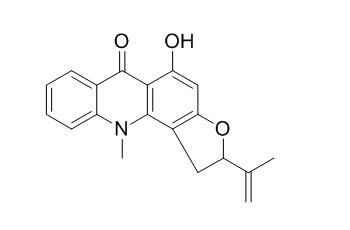Rutacridone
Rutacridone has mutagenicity.
Inquire / Order:
manager@chemfaces.com
Technical Inquiries:
service@chemfaces.com
Tel:
+86-27-84237783
Fax:
+86-27-84254680
Address:
1 Building, No. 83, CheCheng Rd., Wuhan Economic and Technological Development Zone, Wuhan, Hubei 430056, PRC
Providing storage is as stated on the product vial and the vial is kept tightly sealed, the product can be stored for up to
24 months(2-8C).
Wherever possible, you should prepare and use solutions on the same day. However, if you need to make up stock solutions in advance, we recommend that you store the solution as aliquots in tightly sealed vials at -20C. Generally, these will be useable for up to two weeks. Before use, and prior to opening the vial we recommend that you allow your product to equilibrate to room temperature for at least 1 hour.
Need more advice on solubility, usage and handling? Please email to: service@chemfaces.com
The packaging of the product may have turned upside down during transportation, resulting in the natural compounds adhering to the neck or cap of the vial. take the vial out of its packaging and gently shake to let the compounds fall to the bottom of the vial. for liquid products, centrifuge at 200-500 RPM to gather the liquid at the bottom of the vial. try to avoid loss or contamination during handling.
Int J Mol Sci.2020, 21(6):2190.
Food Chem.2019, 290:286-294
Fermentation2023, 9(10), 889
Sains Malaysiana2022, 51(4):1143-1154
Neurochem Int.2020, 133:104629
Molecules.2019, 24(10):E1930
Materials Today Communications2023, 37:107216
Exp Biol Med (Maywood).2019, 244(18):1665-1679
Int J Mol Sci.2020, 21(9):3392.
Food Bioscience2023, 56:103311.
Related and Featured Products
Mutagenesis. 1991 Nov;6(6):501-6.
Inhibitory effects of furocoumarins in Salmonella typhimurium TA98 on the mutagenicity of dictamnine and rutacridone, promutagens from Ruta graveolens L.[Pubmed:
1800898]
Eight furocoumarins differing in their basic structure and substitution pattern (angular, linear, dihydrofuran type) were tested for their ability to reduce the mutagenic potency of dictamnine and Rutacridone, two alkaloids present in extracts from Ruta graveolens L.
METHODS AND RESULTS:
Both compounds need metabolic activation by S9 mix in order to exhibit mutagenicity in Salmonella typhimurium strain TA98. The furocoumarins used in this study did not show any mutagenicity either with or without S9 mix within the dose range tested. However, all the furocoumarins were able to inhibit the mutagenicity induced by dictamnine as well as by Rutacridone in a dose-dependent manner. Imperatorin turned out to be the most efficient inhibitor. The inhibitory effect is probably due to the inactivation of the cytochrome P450 enzyme complex which prevents the activation of the promutagens.
CONCLUSIONS:
This is indicative of the desmutagenic character of the furocoumarins. However, there is also some evidence that the reduction of the mutagenicity induced by dictamnine might be caused to a small extent by a mechanism which possibly depends on the competition with furocoumarins for the same sites in the DNA molecule.
Phytochemistry. 2004 Apr;65(8):1095-100.
Specific accumulation and revised structures of acridone alkaloid glucosides in the tips of transformed roots of Ruta graveolens.[Pubmed:
15110689]
The root tips of Ruta graveolens (common rue) show strong autofluorescence of acridone alkaloids, which are characteristic secondary metabolites of this plant.
METHODS AND RESULTS:
To study the specific distribution and accumulation of acridone alkaloids in various root segments of Ruta graveolens, root material was harvested from genetically transformed root cultures and extracts were investigated by chromatographic techniques and HPLC-(1)H NMR spectroscopy. The cells of the elongation and differentiation zones contained acridone glucosides and large amounts of acridone alkaloids, mainly Rutacridone.
CONCLUSIONS:
Gravacridondiol glucoside was identified as the dominant secondary compound of the root tips and its structure revised by means of spectroscopic methods. In addition, minor acridones, including the structurally revised gravacridontriol glucoside and unknown natural products, were found in the root tip.



